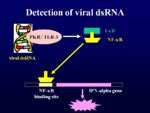Difference between revisions of "Innate Immunity to Viruses"
m (Text replace - "Category:To Do - Blood" to "Category:To Do - BloodCategory:To Do - Clinical") |
|||
| (7 intermediate revisions by 3 users not shown) | |||
| Line 1: | Line 1: | ||
[[Image:Innate viral response.jpg|thumb|right|150px|Innate response to dsRNA - B. Catchpole, RVC 2008]] | [[Image:Innate viral response.jpg|thumb|right|150px|Innate response to dsRNA - B. Catchpole, RVC 2008]] | ||
| − | + | Because viruses invade host cells to take over a host's cellular machinery, the innate system has a more difficult time detecting viruses as foreign agents. However, there is a give-away element of the viral attack that the innate system can recognize: the '''double-stranded RNA''' (dsRNA) produced by a virus in its replication phase. Because mammalian cells only ever produce single-stranded RNA, the presence of dsRNA signals a foreign intruder. dsRNA can be detected by TLR-3R on the cell surface or intracellularly by the presence of dsRNA-dependent protein kinase. | |
| − | Because viruses invade host cells to take over a host's cellular machinery, the | ||
| − | |||
| − | |||
| − | + | The innate response to viral attack also depends on the presence of '''Type-1 Interferons''', which are produced by all cells on recognition of a viral attack. Interferons serve to increase degradation of mRNA, inhibit protein synthesis, and increase the effectiveness of the adaptive response by increasing antigen presentation to antibody. | |
| − | |||
| − | |||
| − | |||
| − | |||
| − | + | Lastly, the final line of defense for the innate response to viruses lies in the actions of [[Natural Killer cells|'''Natural Killer (NK) cells''']]. These warriors monitor the production of [[Major Histocompatability Complexes|MHC]] (Major Histocompatibility Complex) on the surface of cells, which is produced as part of the adaptive response. A cell whose cellular machinery is compromised by viral infection will experience a drop in the amount of MHC it produces. When a cell's MHC production drops, NK cells are triggered to phagocytose these cells. As such, this is a non-specific targeting based simply on the ability of a cell to function normally, which also lends them to playing a role in targeting malignant cells. NK cells are incapable of directly targeting viral infection. | |
| − | |||
| − | | | ||
| − | + | <big>'''Also see [[Immunity to Viruses]]'''</big> | |
| + | [[Category:To Do - Blood]][[Category:To Do - Clinical]] | ||
[[Category:Innate Immune System]] | [[Category:Innate Immune System]] | ||
| − | |||
Revision as of 10:55, 20 August 2010
Because viruses invade host cells to take over a host's cellular machinery, the innate system has a more difficult time detecting viruses as foreign agents. However, there is a give-away element of the viral attack that the innate system can recognize: the double-stranded RNA (dsRNA) produced by a virus in its replication phase. Because mammalian cells only ever produce single-stranded RNA, the presence of dsRNA signals a foreign intruder. dsRNA can be detected by TLR-3R on the cell surface or intracellularly by the presence of dsRNA-dependent protein kinase.
The innate response to viral attack also depends on the presence of Type-1 Interferons, which are produced by all cells on recognition of a viral attack. Interferons serve to increase degradation of mRNA, inhibit protein synthesis, and increase the effectiveness of the adaptive response by increasing antigen presentation to antibody.
Lastly, the final line of defense for the innate response to viruses lies in the actions of Natural Killer (NK) cells. These warriors monitor the production of MHC (Major Histocompatibility Complex) on the surface of cells, which is produced as part of the adaptive response. A cell whose cellular machinery is compromised by viral infection will experience a drop in the amount of MHC it produces. When a cell's MHC production drops, NK cells are triggered to phagocytose these cells. As such, this is a non-specific targeting based simply on the ability of a cell to function normally, which also lends them to playing a role in targeting malignant cells. NK cells are incapable of directly targeting viral infection.
Also see Immunity to Viruses
